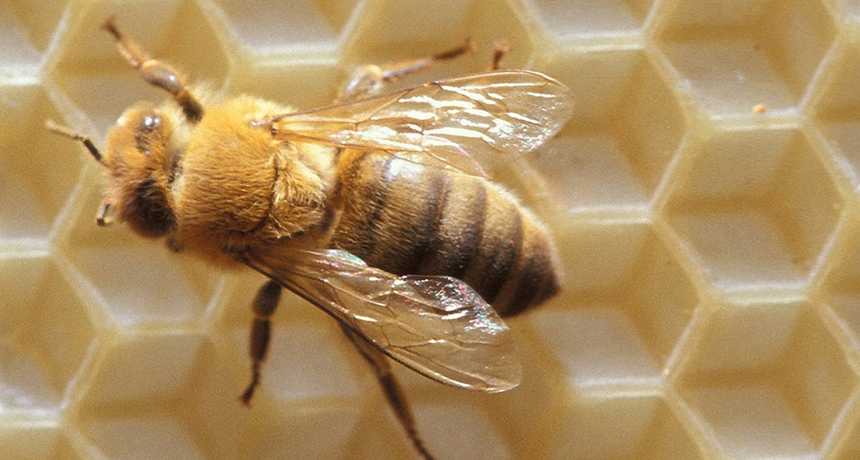Honey’s hidden helper
Scientists identify a substance in honey that helps bee bodies fight poisons

A new study identified compounds in honey that help bees fight off germs.
Jack Dykinga, USDA Agricultural Research Service, Bugwood.org
Honeybees have a weakness for sugar. They sip a sweet beverage called nectar from flowers. And during winter, these insects live off of the honey they made from it. Now scientists have found something in honey that offers more than calories. The food also contains chemicals that might be thought of as medicine. They work by helping bees fight off germs and rid their bodies of poisons picked up in the environment.
Poisons are toxic chemicals. Honey can help a bee rid its body of these by turning on a certain gene. (Genes are found in almost every living cell and contain the instructions for how to keep a cell functioning.) The bees have some genes that trigger processes to detoxify a poison. They work by helping the body break down the poison. Findings linking honey to the activity of these genes appeared April 29 in the Proceedings of the National Academy of Sciences.
These so-called detox genes are important in honeybees. The insects often encounter pesticides. These toxic chemicals are applied to crops to combat other insects or organisms. A 2010 survey of insects and hives in 23 states and one Canadian province found bees face exposure to 121 different pesticides.
Insect specialist May Berenbaum led the new study. Her team at the University of Illinois at Urbana-Champaign focused on a substance in honey called p-coumaric acid. It’s found in the outer coat of pollen. The researchers discovered it plays an important role in activating detox genes. Bees encounter this powdery substance as they flit from flower to flower. They also collect pollen to make into food for young bees. Although honey is made mostly from nectar, bits of pollen may end up in it.
Honey with its p-coumaric acid is good winter food for bees. But the insects often end up eating something else. Many beekeepers sell much of their hives’ honey. So during the winter months, they feed their bees a form of sugar to keep them from going hungry. That substitute is usually sugar water or high-fructose corn syrup (fructose is an especially sweet sugar).
These food replacements may be missing p-courmaric acid. So it’s possible commercial beekeepers need to re-examine their honey substitutes for bees, Berenbaum says.
However, she told Science News, “I do want to make sure that beekeepers don’t immediately run out and start mixing p-coumaric acid with their high-fructose corn syrup.” This is new research. Scientists don’t yet know what dose of p-coumaric acid might help the bees — and whether too much might cause harm.
This new link between honey and bee health fits with what scientists have seen in the field, says Dennis vanEngelsdorp. He’s an entomologist, or scientist who studies insects, at the University of Maryland in College Park. Bad weather can limit how much pollen bees gather during the fall. When that happens, he notes, hives have a harder time surviving through the winter.
Power Words
nectar A sugary fluid secreted by plants, especially within flowers. It encourages pollination by insects and other animals. It is collected by bees to make into honey.
gene A sequence of DNA that determines a particular characteristic in an organism. Genes are passed from parents to children, and contain the instructions for building proteins.
cell The smallest structural and functional unit of an organism. It is typically too small to see with the naked eye.
detoxify To remove or render harmless a toxic substance.
pesticide A substance used for destroying insects or other organisms harmful to cultivated plants or to animals.
pollen A fine, powdery substance, typically yellow, of microscopic grains from the male part of a flower.
entomology The study of insects.







